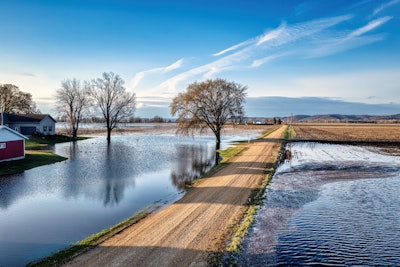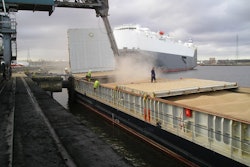
Nobody can dispute that global grain trade is the backbone of our food system. Wheat, rice, corn and other grains are staples in the diets of billions of people worldwide. The same is true for feeding livestock and poultry worldwide.
There is an intricate web of trade that connects farmers, consumers and industries across the globe. The stability (as evidenced by recent events) and sustainability (as we have come to understand it) of this crucial system, however, appear to be under threat due to the impacts of climate change.
Here, we will not debate climate change but rather possible effects from such a phenomenon. How will climate change affect global grain trade? Let's explore some strategies to address these challenges. We'll also highlight opportunities that arise as we adapt to a changing world.
Understanding climate change and its impacts on grain production
According to most authorities, climate change refers to long-term changes in temperature, precipitation and other atmospheric conditions. It is no longer referred to just as global warming, as it now encompasses a range of wider disruptions to our climate systems. When such changes materialize, they may have profound effects on agriculture, including grain production and trade.
- Shifts in growing seasons: One significant effect of climate change can be the alteration of growing seasons. Rising temperatures can cause crops to mature earlier or later than usual, making it difficult for farmers to predict harvest times accurately. This can lead to severe supply imbalances in the global grain market.
- Increased extreme weather events: Climate change has been linked to more frequent and severe weather events, such as droughts, floods and storms. These events can destroy crops, disrupt transportation routes and damage infrastructure crucial for grain storage and distribution. This becomes extremely important for grain transported via water routes.
- Changing rainfall patterns: Changes in precipitation patterns can affect grain yields. Some regions may experience prolonged droughts, while others may face excessive rainfall, both of which can harm crop production. The emergence of sorghum as a water-preserving grain is no mere chance.
Potential impact on global grain trade
The effects of climate change on grain production can ripple through the global grain trade system if the above happen frequently and with great severity.
This can lead to the following challenges:
- Price volatility: Uncertainty in grain production due to climate change can lead to tremendous price volatility. When crop yields are unpredictable, prices tend to fluctuate more, impacting producers and consumers. Geopolitical challenges have demonstrated how fragile global grain trade remains.
- Disruptions in supply chains: Extreme weather events can disrupt supply chains, making it difficult to transport grains from where they are grown to where they are needed. This can lead to shortages and higher prices in importing regions, especially in countries where famine is part of everyday life.
- Trade barriers: In response to these disruptions, some countries or groups of countries might impose trade barriers such as export restrictions or quotas to safeguard their domestic food security. These barriers can exacerbate global food shortages and price spikes. Again, this will hit harder those countries that rely exclusively on imported grains for their population.
- Relocation of production: As climate conditions shift, some regions may become less suitable for grain production while others become more favorable. This can lead to changes in the geography of grain production and trade. This is already happening in some Mediterranean regions where drought-resistant crops are becoming increasing popular.
Adapting to climate change
While the challenges to the global grain trade posed by climate change can seem daunting, there are several strategies that may help us adapt and ensure food security for the future. These included but are not limited to the following:
- Investing in resilient crop varieties: Developing and promoting the use of grain crop varieties that are more resilient to changing climate conditions can help stabilize grain production.
- Improving water management: Water remains crucial for agriculture, and climate change can affect water availability. Implementing better water management practices, such as efficient irrigation systems and water-reserving crops may help mitigate these effects.
- Enhancing infrastructure: Building resilient infrastructure, including transportation networks and storage facilities, can reduce the impact of extreme weather events on grain distribution. This is not on the agenda, however, as we are just starting to experience the unpredictable nature of climate change.
- Diversifying sources: To reduce the risk of supply disruptions, countries can diversify their sources of grain imports. Relying on a single supplier makes a nation or a single animal farmer vulnerable to that supplier's climate-related challenges.
- International cooperation: Global challenges like climate change require international cooperation. Nations must work together to address climate-related disruptions to the grain trade effectively. Of course, international cooperation at any level remains a challenge by itself.
Opportunities amid the challenges
While climate change presents numerous challenges to the global grain trade, it also offers opportunities for innovation and adaptation.
- Technology advancements: Climate-smart technologies, such as precision agriculture and advanced weather forecasting, can help farmers optimize their production and reduce losses.
- Alternative grains: Researchers are exploring the potential of alternative grains that may be more resilient to climate change, including millets and sorghum. These grains could become vital components of future global food security.
- Carbon farming: Practices like carbon farming, which sequester carbon in the soil, not only combat climate change but also enhance soil health and productivity. This is a promising technology, but at the moment, it lacks proper support in terms of farmer education.
- Sustainable practices: The need to adapt to climate change is driving interest in sustainable farming practices that can mitigate climate change and increase crop yields. One such example is the "farming" of sun energy with solar panels, which is being adopted by many producers.
- Green supply chains: Consumers are increasingly demanding sustainably produced food. Companies in the grain trade can capitalize on this by creating more environmentally friendly supply chains. The question remains, however, why consumers refuse to pay for such demand.
Climate change poses significant challenges to the global grain trade. Shifts in growing seasons, extreme weather events and changing precipitation patterns all threaten the stability of this essential system. By investing in resilience, improving infrastructure and promoting international cooperation, however, we can adapt to these challenges.
Moreover, climate change presents opportunities for innovation and sustainable practices that not only mitigate its effects but also improve global food security in the long run. The global grain trade is at a crossroads, and how we respond to the challenges of climate change will determine its future.















